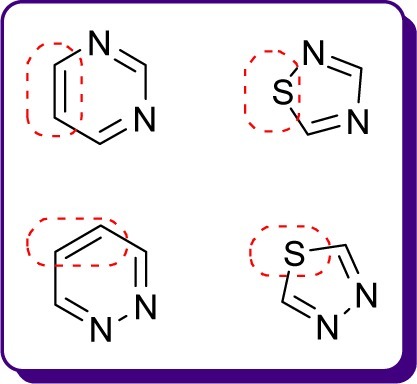Abstract
Pathogenic microorganisms are causative agents for different types of serious and even lethal infectious diseases. Despite advancements in medication, bacterial and fungal infections continue to be a growing problem in health care. As more and more bacteria become resistant to antibiotics used in therapy and an increasing number of invasive fungal species become resistant to current antifungal medications, there is considerable interest in the development of new compounds with antimicrobial activity. The compounds containing a heterocyclic ring play an important role among organic compounds with biological activity used as drugs in human and veterinary medicine or as insecticides and pesticides in agriculture. Thiadiazoles belong to the classes of nitrogen–sulfur heterocycles with extensive application as structural units of biologically active molecules and as useful intermediates in medicinal chemistry. The potency of the thiadiazole nucleus is demonstrated by the drugs currently used. 1,3,4-Thiadiazoles and some of their derivatives are extensively studied because of their broad spectrum of pharmacological activities. The aim of this review was to highlight the main antimicrobial properties exhibited by derivatives possessing 2-amino-1,3,4-thiadiazole moiety. Many of the reported 2-amino-1,3,4-thiadiazole derivatives can be considered as lead compounds for drug synthesis, and several of them have demonstrated higher antimicrobial activity in comparison to standard drugs. Furthermore, taking into account the reactivity of the amine group in the derivatization process, 2-amino-1,3,4-thiadiazole moiety may be a good scaffold for future pharmacologically active 1,3,4-thiadiazole derivatives.
Introduction
Heterocyclic compounds play an important role among organic compounds with biological activity used as drugs in human and veterinary medicine or as insecticides and pesticides in agriculture. Chemical rings, which are present in many marketed drugs, may possess pharmacological properties or may serve as a platform for the pharmacophoric groups which will interact with the receptors.Citation1
Thiadiazoles belong to the classes of nitrogen–sulfur containing heterocycles with extensive application as structural units of biologically active molecules and as useful intermediates in medicinal chemistry. There are several isomers of the thiadiazole ring (eg, 1,2,3-thiadiazole, 1,2,4-thiadiazole, 1,2,5-thiadiazole and 1,3,4-thiadiazole; ). During the past years, substituted 1,3,4-thiadiazole derivatives have received significant attention and have been increasingly investigated due to their broad spectrum of pharmacological properties. It is supposed that 1,3,4-thiadiazole derivatives exhibit various biological activities due to the presence of =N–C–S–moiety.Citation2 Other authors assume that the biological activities of 1,3,4-thiadiazole derivatives are due to the strong aromaticity of the ring, which also provides great in vivo stability to this five-membered ring system and low toxicity for higher vertebrates, including human beings.Citation3
There are some studies that show the importance of isosterism for the pharmacological profile of a compound. According to these studies, 1,2,4-thiadiazole is the bioisostere of pyrimidine, while the 1,3,4-thiadiazole is the bioisostere of pyridazine through the substitution of –CH=CH– by –S– ().Citation4,Citation5 The thiadiazole ring is also a bioisostere of oxadiazole, oxazole, thiazole and benzene ring.Citation4,Citation6 The bioisosteric replacement of a ring with another ring might lead to compounds with increased lipophilicity and improved biological properties. The thiadiazole derivatives, due to the presence of sulfur atom that gives high liposolubility, show oral absorption and good cell permeability leading to a good bioavailability. In addition, substitution of a homocyclic ring with a heterocycle makes the synthesis of different analogs possible which interact more with the receptors.Citation4,Citation7,Citation8
Considering the high prevalence of pyrimidine derivatives in nature and also the presence of pyridazine ring in compounds possessing pharmacological activities (eg, the antidepressant, minaprine; GABA-A antagonist, gabazine; nonsteroidal anti-inflammatory drug, emorfazone and the antibacterial cephalosporin, cefozopran), the potential of thiadiazole derivatives to exhibit biological activities is very high.Citation9–Citation11
Moreover, 1,3,4-thiadiazole derivatives can produce mesoionic salts (). Mesoionic system contains a pentatomic heterocyclic ring which possesses a sextet of p and π electrons and positive charge counterbalanced by formal negative charge. Despite their internal charges, the mesoionic compounds are neutral and able to cross cellular membranes, and this contributes to the good cell permeability of 1,3,4-thiadiazole derivatives. The mesoionic nature of 1,3,4-thiadiazoles enables these compounds to interact strongly with biomolecules (eg, DNA and proteins).Citation4,Citation12
Figure 3 Chemical structure of the mesoionic salt derivatives formed by 1,3,4-thiadiazole compounds.
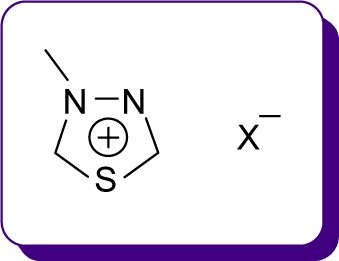
The biological importance of 1,3,4-thiadiazole derivatives has been reported following the discovery of heterocyclic sulfonamides as reasonable antimicrobial agents (eg, sulfathiazole 1; Winthrop Chemical Company, NY, USA, 1940).Citation13,Citation14 In analogy to sulfathiazole, other sulfonamides showing similar activity such as “sulfamethizole” 2 (4-amino-N-(5-methyl-1,3,4-thiadiazol-2-yl)benzene sulfonamide, Rufol [Urgo Laboratories, Chenove, France])Citation15,Citation16 or “sulfaethidole” 3 (4-amino-N-[5-ethyl-1,3,4-thiadiazol-2-yl]benzene sulfonamide, Globucid [Schering, Berlin, Germany])Citation17 were prepared. Except sulfathiazole that is still used in the treatment of Haemophilus vaginalis vaginitis,Citation18 sulfamethizole and sulfaethidole currently possess only historical importance.
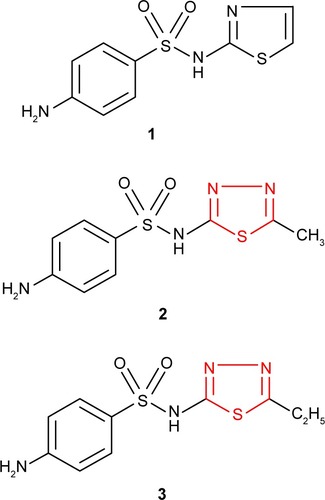
The synthesis of “acetazolamide” 4 (5-acetylamino-1,3,4-thiadiazol-2-sulfonamide) by Roblin and ClappCitation19 (Lederle Laboratories, Pearl River, NY, USA) as carbonic anhydrase inhibitor reoriented the researchers to sulfonamides bearing 1,3,4-thiadiazole ring. Acetazolamide was marketed as Diamox (Lederle Laboratories, American Cyanamid Company, Pearl River, NY, USA) in 1954.Citation19–Citation21 Although its use as a diuretic is limited by systemic acidosis as a side effect,Citation22 acetazolamide is currently a good antiglaucoma agent. Its methylated derivative, “methazolamide” 5 (Neptazane [Fera Pharmaceuticals, Locust Valley, NY, USA]), is a more potent carbonic anhydrase inhibitor and displays diuretic, antiglaucoma and potential antineoplastic activity.Citation23

Olsen et alCitation24 discovered the cytostatic properties of “2-amino-1,3,4-thiadiazole,” having as a result many publications that launched new 1,3,4-thiadiazole derivatives with potential anticancer activity.
The synthetic studies concerning the therapy of parasitic infections gave “megazol” 6 (2-amino-5-[1-methyl-5-nitro-1H-2-imidazolyl]-1,3,4-thiadiazole, CL 64855),Citation25 a nitroimidazole extremely active in experimental infections caused by Trypanosoma cruzi and Trypanosoma brucei as well as drug-resistant forms of trypanosomiasis. Megazol has been found to be the best-known anti-trypanosomal candidate for the treatment of sleeping sickness in Africa and Chagas disease in South America. However, due to the high toxicity (mutagenic and genotoxic properties), its development has been postponed, but it serves as a lead compound for the development of new anti-trypanosomal agents.Citation26–Citation31
1,3,4-Thiadiazole ring is the constitutive part of some cephalosporins and cephamycins that showed high in vitro activity against both Gram-positive and Gram-negative bacteria. A good example is “cefazolin” 7, a first-generation cephalosporin which has been used worldwide since the early 1970s (GlaxoSmithKline plc, London, UK; Ancef).Citation32,Citation33

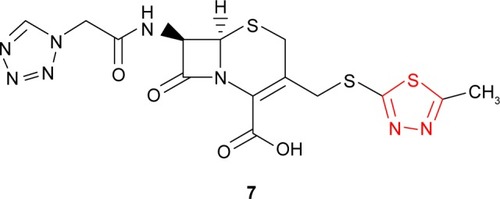
Cefazolin is a semisynthetic cephalosporin for parenteral treatment of bacterial infections in various organs, including septicemia.Citation32–Citation34 The treatment of infections with penicillins and cephalosporins failed many times due to the methicillin-resistant Staphylococcus aureus (MRSA) strains. As a result, the use of glycopeptide antibiotics (eg, vancomycin and teicoplanin) was increased. During the past years, vancomycin-resistant strains were found. To prevent the development of drug resistance, several clinical studies to compare the efficacy of cefazolin vs teicoplanin and vancomycin, respectively, were initiated. The results proved that, for the prevention of surgical-site infections, cefazolin might be the first-line medication.Citation34–Citation38
1,3,4-Thiadiazole ring is an important scaffold known to be associated with several biological activities including antimicrobial,Citation39–Citation41 antituberculosis,Citation42 antiviral,Citation43 analgesic,Citation44 antidepressant and anxiolytic,Citation45 antihypertensive,Citation46 anti-convulsant, anti-inflammatory,Citation47,Citation48 local anestheticCitation49 and kinesin inhibitors.Citation50,Citation51 During the past 2 decades, the number of scientific publications concerning the synthesis and biological investigation of 1,3,4-thiadiazoles has considerably increased. In addition, the amine derivatives of 1,3,4-thiadiazole are also studied. Aliphatic and aromatic amines are important moieties in many natural or synthetic biologically active compounds. Naturally occurring amines include alkaloids such as ephedrine and pseudoephedrine, which are present in several drug combinations, and catecholamine neurotransmitters (dopamine, epinephrine and norepinephrine) are essential for the proper activity of the nervous system and valuable drugs used in therapy. It is not surprising that more than 75% of drug candidates contain free or substituted amine groups.Citation52,Citation53
The cytostatic properties of 2-amino-1,3,4-thiadiazole and the anti-trypanosomal properties of megazol are evidence of the biological potential of 2-amino-1,3,4-thiadiazole moiety. The aim of this review was to highlight the main antimicrobial properties exhibited by derivatives possessing 2-amino-1,3,4-thiadiazole moiety. Furthermore, taking into account the reactivity of the amine group in the derivatization process, 2-amino-1,3,4-thiadiazole moiety may be an excellent scaffold for future pharmacologically active 1,3,4-thiadiazole derivatives. The covalent bonding of biologically active compounds with similar effect but acting by different mechanisms could lead, by synergism, to compounds with improved activity and less toxicity.Citation54 Some of the derivatives included in this review have the 1,3,4-thiadiazole ring linked to different homocyclic cores but many of them are bis- or polyheterocyclic compounds bearing the thiadiazole moiety linked to other heterocyclic rings. In addition, this review provides some information about structure–activity relationship (SAR) studies.
Antimicrobial activities associated with 2-amino-1,3,4-thiadiazole system
Pathogenic microorganisms are causative agents for different types of diseases such as upper and lower respiratory tract infections, typhoid fever, gastrointestinal infections, gynecological infections, sexually transmitted diseases, urinary tract infections, bacterial meningitis, osteomyelitis and malaria and also for severe diseases such as tuberculosis, influenza, syphilis and acquired immunodeficiency syndrome (AIDS). Taking into account that infectious diseases affect millions of people and cause many deaths worldwide, it can be said that anti-infective agents have saved more lives than other classes of drugs.Citation55
Antibacterial and antifungal activities
The antimicrobial chemotherapy is the way to combat infections through the pharmacological effects of the drugs used. Antimicrobial agents have specific toxic action on pathogenic organisms. Since the introduction of the first antibiotic (penicillin, 1942) into medical practice, there has been an ongoing race between scientists and pathogenic bacteria.Citation56 In the struggle for existence, the microorganisms constantly adapt by selecting higher invasive and more resistant strains. Despite the large number of antibiotics and chemotherapeutics available for medical use, the bacterial infections have dramatically increased due to bacterial resistance to antimicrobial drugs. On the other hand, the spread of HIV infection combined with the increased use of powerful immunosuppressive drugs for cancer therapy and organ transplants led to increased incidence of fungal infections among immunocompromised patients. Although most fungal infections were superficial in the past, the incidence of systemic fungal infections has currently increased.Citation55,Citation57 The gravity of bacterial and fungal infections became a major worldwide problem, and the World Health Organization chose the antimicrobial resistance as the theme of the 2011 World Health Day. Due to the occurrence of bacterial resistance (eg, MRSA that is resistant to many antibiotics), researchers are in a continuous effort to counteract infections by synthesizing new effective antibacterial and antifungal agents.Citation56,Citation58–Citation60
Thiadiazole ring acts as a pharmacophore. It is also a bioisostere of the thiazole ring included in the third- and fourth-generation cephalosporins, and this observation makes it possible to use it in the synthesis of antimicrobial agents.Citation61
Upadhyay and MishraCitation62 synthesized the 5-(4-substituted phenyl)-1,3,4-thiadiazol-2-amine derivatives 8 and performed in vitro antibacterial activity against S. aureus, Bacillus subtilis, Escherichia coli and Pseudomonas aeruginosa and antifungal activity against Aspergillus niger and Candida albicans by disk diffusion technique. Fluorinated and chlorinated compounds 8a and 8b showed good inhibitory effects (inhibition between 81% and 91%) with minimum inhibitory concentration (MIC) values of 20–28 μg/mL (controlled to ciprofloxacin, MIC =18–20 μg/mL) for S. aureus and B. subtilis. In addition, halogenated compounds 8a-c and hydroxyl derivative 8d showed moderate inhibitory effects (inhibition between 58% and 79%) with MIC values of 24–40 μg/mL (controlled to ciprofloxacin, MIC =20–24 μg/mL) for E. coli and P. aeruginosa. Significant antifungal activity against A. niger and C. albicans was exhibited by derivatives 8d and 8e bearing oxygenated substituents at phenyl ring (inhibition between 58% and 66% and MIC =32–42 μg/mL compared to fluconazole, MIC =24–26 μg/mL). It appears that the halogen attached to the phenyl-1,3,4-thiadiazol moieties increases the antibacterial activity with preference against Gram-positive bacteria, while the oxygenated substituents impart antifungal activity.
A new series of 4-amino-2-{5-[(4-substituted phenyl) amino]-1,3,4-thiadiazol-2-yl}phenols 9 was synthesized, and the compounds were in vitro evaluated for their antimicrobial activity. Among the series 9, the chlorinated and fluorinated derivatives 9d-f exhibited good antibacterial activity against S. aureus and E. coli strains and antifungal activity against A. niger with MIC values of 25 μg/mL.Citation63
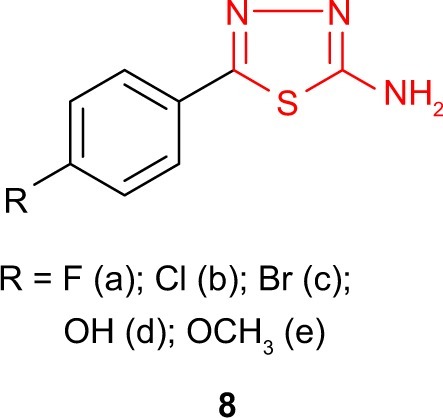
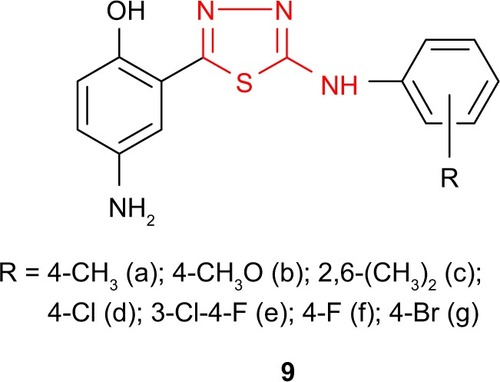
Other fluorinated compounds incorporating 1,3, 4-thiadiazole ring and the diflunisal (a nonsteroidal anti-inflammatory drug) structure were tested for antimicrobial activity using microwell dilution assay and MIC agar dilution assay. 5-(2′,4′-Difluoro-4-hydroxybiphenyl-5-yl)-phenylamino-1,3,4-thiadiazole 10 showed activity against E. coli and Streptococcus pyogenes at a concentration of 31.25 μg/mL (inhibition zone of 16–18 mm), two times greater than that observed for the control drug, ofloxacin (MIC =62.5 μg/mL). In addition, another standard drug, cefepime, was found less active against the bacteria mentioned earlier.Citation64
Kadi et alCitation54,Citation65 have synthesized new 2-(1-adamantylamino)-5-substituted-1,3,4-thiadiazole derivatives 11. The investigation of antimicrobial screening of the synthesized compounds revealed that the best antibacterial activity was exhibited by the p-chlorophenyl 11c and p-nitrophenyl 11e derivatives against Gram-positive microorganisms such as B. subtilis and S. aureus. Only p-nitrophenyl derivative 11e showed good activity against the Gram-negative bacteria E. coli in comparison to the reference drug, ampicillin. SAR studies have shown that the introduction of another adamantyl moiety on C-5 of thiadiazole ring increased the antifungal activity against C. albicans.

The in vitro antimicrobial activity of some new 1,3,4-thiadiazole derivatives such as 12 having a D,L-methionine moiety has been evaluated against several bacterial strains by Pintilie et al.Citation66 From the findings, the authors revealed that 1,3,4-thiadiazole derivatives have good activity against Bacillus anthracis and Bacillus cereus, the most active compound 12c possessing a 4-methylphenyl moiety on the heterocyclic ring. The compounds showed a very weak activity against S. aureus and E. coli strains and were inactive against Sarcina lutea strain. The antimicrobial activity of some thioethers derived from 2-amino-5-mercapto-1,3,4-thiadiazole was found to be dependent on the substitution at the mercapto group. Even though all the tested compounds showed moderate antibacterial activity against Gram-positive and Gram-negative bacterial strains and moderate to good antifungal activity against C. albicans, the findings revealed that the antimicrobial activity was improved by the introduction of a 1-arylethanone moiety at the mercapto group. The unsubstituted and halogenated aryl derivatives 13 proved to be the most active compounds against Salmonella typhimurium and C. albicans.Citation67
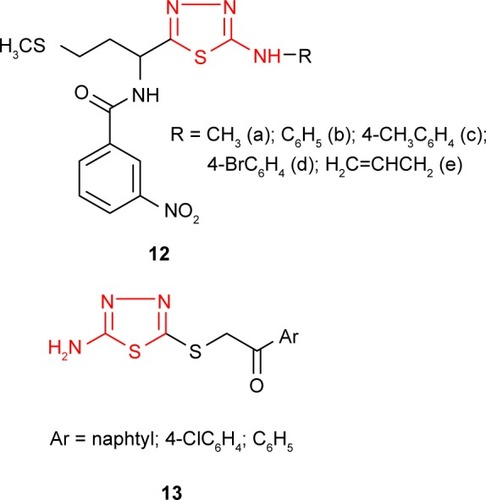
A series of 5-substituted 2-(2,4-dihydroxyphenyl)-1,3,4-thiadiazole derivatives such as 14 synthesized by Matysiak and MalinskiCitation68 has been evaluated for anti-fungal activity against C. albicans and Candida non-albicans species. Many derivatives exhibited higher activity against C. nonalbicans species compared to standard drugs, itraconazole (MIC =85.6 μg/mL) and fluconazole (MIC =120.8 μg/mL), 2,4-dichlorophenylamino derivative 14d (MIC =37.8 μg/mL) and morpholinoethylamino derivative 14f (MIC =34.4 μg/mL) being the most active compounds. The aminoderivatives substituted with the methyl, phenyl, halogenophenyl, ethoxyphenyl and morpholinoalkyl groups showed higher antifungal activity against C. albicans strains. For some of them, such as phenylamino derivative 14b (MIC =36.3 μg/mL) and 2,4-dichlorophenylamino derivative 14d (MIC =32.6 μg/mL), an activity higher than that of itraconazole (MIC =47.5 μg/mL) was observed. A number of 2-amino-1,3,4-thiadiazoles substituted at C-5 of thiadiazole ring with the phenyl or phenol group showed moderate to significant antibacterial and antifungal activities against Gram-positive bacteria (S. aureus and B. cereus), Gram-negative bacteria (E. coli and P. aeruginosa) and fungal strains (A. niger and Aspergillus fumigatus) compared to standard drugs, streptomycin and fluconazole. The compounds 15 possessing the p-nitroaniline moiety showed the most promising antibacterial and antifungal properties.Citation69
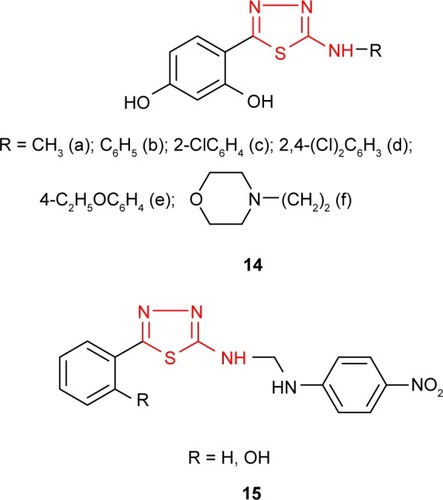
Some nitrophenoxymethyl-1,3,4-thiadiazole derivatives such as 16 synthesized by Shah et alCitation70 were evaluated for antimicrobial activity. The introduction of the nitro group significantly increased the antibacterial activity against S. aureus, the studied compounds exhibiting comparable activity to standard drugs, chloramphenicol and ampicillin. In comparison, the acetamidophenoxymethyl-1,3,4-thiadiazole derivatives 17 exhibited moderate antibacterial activities against B. subtilis. The introduction of p-tolyl substituent (compound 17b) at the amine group of 1,3,4-thiadiazole ring significantly increased the activity.Citation71
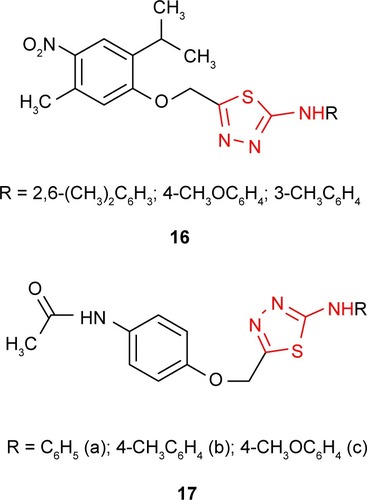
Having 5-(4-chlorophenylamino)-2-mercapto-1,3,4-thiadiazole as starting material, Sah et alCitation72 have synthesized the Mannich base which was converted to the corresponding formazans with aromatic, benzenesulfonic acid or sulfonamide moiety. Among the synthesized compounds, the aromatic formazans 18 were the most active compounds showing good activity (zone of inhibition of 15–19 mm) against Salmonella typhi strain (compound 18a) and E. coli strain (compound 18b) at the concentration of 500 μg/disk. The same compounds showed good antifungal activity against A. niger and/or Penicillium sp. and only moderate activity against C. albicans.
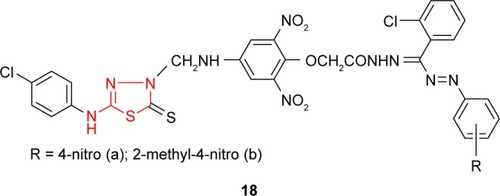
Dogan et alCitation73 have examined the effect of various substitutions at the amine group of 2-amino-5-(3-hydroxy-2-naphthyl)-1,3,4-thiadiazole on antimicrobial activity against different bacterial and fungal strains. Among the series, the p-chlorophenyl derivative 19 was marginally active against S. aureus (MIC value of 62.5 μg/mL), and it may be considered for the development of new antibacterial agents.
Insertion of a long alkenyl/hydroxyalkenyl chain to the fifth position of 1,3,4-thiadiazole ring is a useful tool in the synthesis of biologically active compounds. Such 5-alkenyl/hydroxyalkenyl-2-phenylamine-1,3,4-thiadiazoles 20 showed good antibacterial activity against E. coli, S. aureus, P. aeruginosa, S. pyogenes and Klebsiella pneumoniae and moderate to good antifungal activity against C. albicans, A. fumigatus, Penicillium marneffei and Trichophyton mentagrophytes. Antimicrobial activity data indicated that derivatives 20a and 20b having a hydroxyalkenyl chain substituent at C-5 are good antibacterial agents with almost equal potency against K. pneumoniae as the reference drug, chloramphenicol. The position of the hydroxyl group did not have a significant influence on the pharmacological effect. The alkenyl derivatives such as 20c were found to be potent antifungal agents compared to standard drug, griseofulvin.Citation74
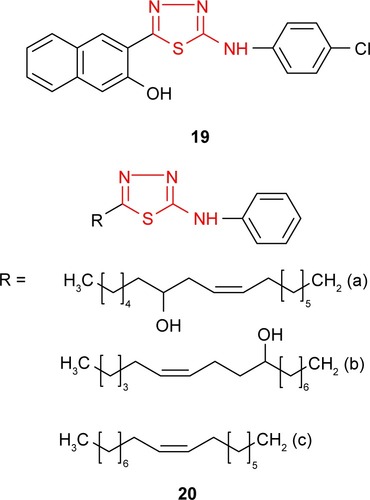
2-Amino-5-R-1,3,4-thiadiazole derivatives have also been investigated for their ability as complexation agents to obtain compounds with enhanced biological properties due to the presence of metal ions. Thus, 5-(2-aminoethyl)-2-amino-1,3,4-thiadiazole 21 and its Cu(II) and Ni(II) complexes 22a-b were reported by Barboiu et al.Citation75 The antifungal activity of the ligand and its metal complexes against two Aspergillus species and C. albicans was investigated. Compared to anti-fungal drug, clotrimazole, the ligand was much less active, while the metal complexes showed an increased antifungal activity. The most active compound, Cu(II) complex 22a, was almost as effective as clotrimazole against A. niger and more effective against Aspergillus flavus. Obaleye et alCitation76 have synthesized 2,5-diamino-1,3,4-thiadiazole 23 as a bioactive ligand and its metal complexes with biologically important ions, such as Co(II), Ni(II) and Cu(II). The ligand behaved as tridentate neutral ligand which coordinated to the metal ions via sulfur and nitrogen of the amines giving solid chelates with general formulae [(ML2)Cl2] and octahedral geometric structures. The in vitro antimicrobial study of the ligand and its metal complexes showed the antibacterial activity of the tested compounds and no antifungal activity against A. niger and Penicillium sp. The most sensitive microorganism to ligand and its metal complexes was Neisseria gonorrhoeae. The metal complexes showed comparable or greater activity against some of the tested microorganisms compared to the ligand. S. typhi, Shigella sp. and P. aeruginosa were more sensitive to the metal complexes than S. aureus, Klebsiella sp. and E. coli. In addition, the metal complexes did not show toxicity against the activity of some kidney, liver and serum enzymes, making these compounds promising candidates for antibacterial treatment.
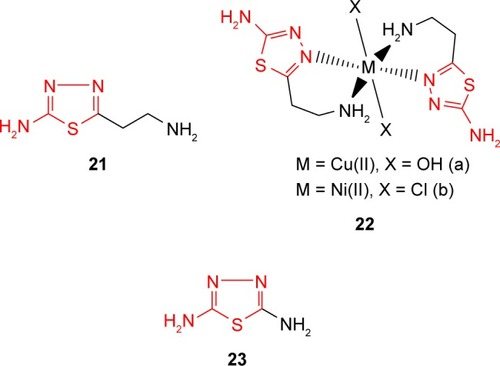
Taking into account that the presence of a heterocyclic ring increases the probability of antimicrobial properties of a compound, bis 1,3,4-thiadiazole derivatives such as 24 have been synthesized from various dicarboxylic acids and were investigated for in vitro antibacterial and antifungal activities. The results showed that the tested compounds exhibited comparable antimicrobial activity with the standard antibiotics such as ciprofloxacin and griseofulvin, the most active compound being the methyl derivative (n=1).Citation77 Moreover, Salimon et alCitation41 described the synthesis of 2,5-di-[5-amino-1,3,4-thiadiazol-2-thiomethyl]-1,3,4-thiadiazole 25 through the reaction of 2,5-dimercapto-1,3,4-thiadiazole with chloroacetic acid and thiosemicarbazide. The antimicrobial screening revealed that the tris-1,3,4-thiadiazole derivative displayed good antimicrobial activity against the Gram-positive bacteria S. aureus and Corynebacterium diphtheriae and yeasts such as Saccha-romyces cerevisiae and weak activity against Gram-negative bacteria. Other tris-2,5-disubstituted 1,3,4-thiadiazole derivatives such as 26 synthesized by Rezki et alCitation78 showed good antibacterial activity against Gram-positive (Streptococcus pneumoniae, B. subtilis, S. aureus) and Gram-negative bacteria (P. aeruginosa, E. coli, K. pneumoniae) and antifungal activity against A. fumigatus, C. albicans, Geotrichum candidum at concentrations ranging between 8 and 31.25 μg/mL.
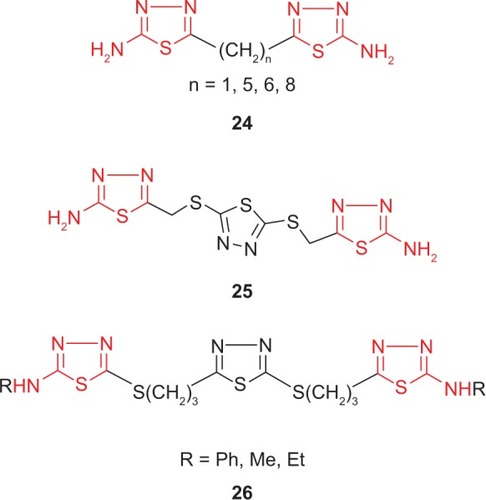
An attempt to prepare active compounds of the thiadiaz-ole derivative series combining the xylosyl moiety and the aryltetrazole ring gave compound 27 exhibiting S. aureus inhibitory activity.Citation79 It is well known that furan derivatives bearing a nitro group in the 5-position and a group of the general type -C=N-N=C-, which may be incorporated in a heterocycle, possess in vivo antibacterial properties. ShermanCitation80 prepared 2-amino-5-(5′-nitro-2′-furyl)-1,3,4-thiadiazole 28 with antibacterial activity in animals after oral or intramuscular administration. The free amine group conferred the maximum antibacterial activity, while the substitution of amine group decreased the activity in the following order: methyl > ethyl > phenyl.
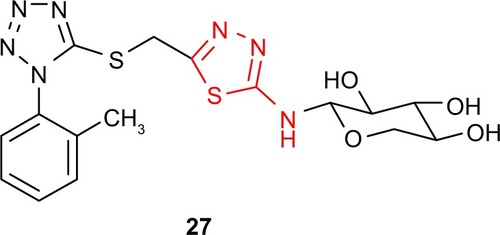
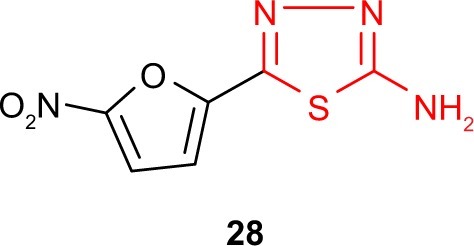
Demirbas et alCitation81 have synthesized several 1-(5-arylamino-[1,3,4]thiadiazol-2-yl)methyl-4-amino-3-R-5-oxo-4,5-dihydro-[1,2,4]triazoles 29 and 30 which exhibited antimicrobial properties on different microbial strains. p-Chlorophenyl derivative 29d and p-methoxyphenylamino derivative 30 showed the most potent antimicrobial activity against the tested microorganisms. For example, compound 30 showed promising antimicrobial activity against all the bacterial strains: E. coli, Yersinia pseudotuberculosis, P. aeruginosa, Enterococcus faecalis, S. aureus, B. cereus (diameter of the inhibition zone ≥20 mm) with the best results against E. coli and P. aeruginosa (diameter of the inhibition zone ≥30 mm). Methyl derivative 29a showed good activity against E. coli, P. aeruginosa, K. pneumoniae and B. subtilis strains (diameter of the inhibition zone ≥17 mm). Benzyl derivative 29e showed good activity against K. pneumoniae (diameter of the inhibition zone ≥17 mm) and moderate activity against E. coli, S. aureus and B. subtilis strains (diameter of the inhibition zone 11–16 mm), while phenyl derivative 29c exhibited moderate activity against K. pneumoniae (diameter of the inhibition zone 11–16 mm) and antifungal activity against Penicillium sp. (diameter of the inhibition zone 20 mm). No antifungal activity was observed on the yeasts such as C. albicans, Candida tropicalis or Candida glabrata. The substitution of the –NH– group in arylamino unit by a hydrophobic methyl group decreased the antimicrobial activity.Citation82,Citation83
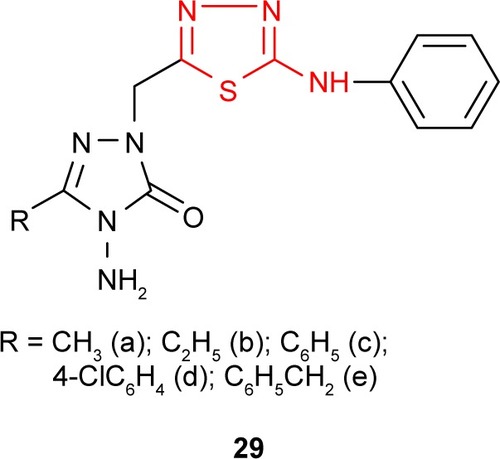
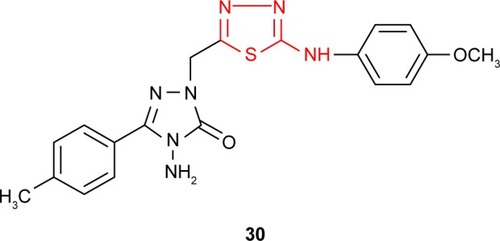
Following the discovery of the natural antimicrobial pyrazole C-glycoside, pyrazofurin, much attention has been given to the pyrazole derivatives. Compounds containing pyrazole moiety attached to the 1,3,4-thiadiazole ring have been synthesized by Bekhit et al.Citation84 Among the studied compounds, the tolyl derivative 31 showed about half of the activity of ampicillin against Gram-positive microorganism S. aureus. Even if the antimicrobial activity is not very high, the complexity of the reported compounds makes them promising pharmacological agents. In the search for new antimicrobial agents, 2-amino-1,3,4-thiadiazole derivatives bearing isomeric pyridyl ring have been synthesized and the antibacterial studies have also been reported. The naphthyl derivative 32 exhibited very weak inhibitory activity against S. aureus and E. coli, while the benzyl derivative 33 was more active than other studied compounds against tested Gram-positive and Gram-negative bacterial strains.Citation85,Citation86
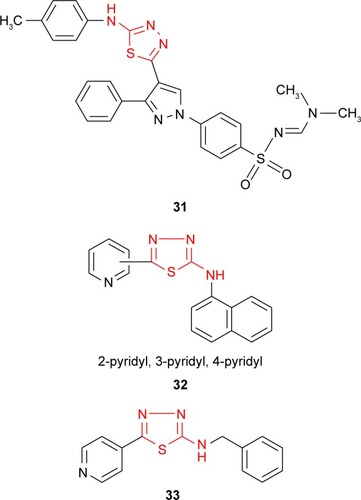
Similar hybrid compounds which have a 2-pyridyl ring linked to 1,3,4-thiadiazol moiety through a methylene group (eg, compound 34) also exhibited moderate activity against some Gram-positive cocci, Gram-negative rods and fungi.Citation87 Some 1,3,4-thiadiazole derivatives such as 35 bearing pyrimidine ring have been tested for in vitro antimicrobial activity against E. coli and Rhizobium spp. Opposite to what was observed in the previous examples, the pyridyl derivatives 35e-f exhibited the best inhibition activity among the tested compounds.Citation88

Andrews et alCitation89 synthesized some new 2-amino-1,3,4-thiadiazole derivatives substituted at C-5 of thiadiazole ring with dihydropyrimidine moiety. The compounds such as 36 were evaluated for in vitro antibacterial activity at a concentration of 10 μg/mL by measuring the inhibition area on agar plates (diffusion method). Moderate activity against E. coli was shown by nitro derivatives 36c-d using dimethyl sulfoxide (DMSO) as a control and ciprofloxacin as standard drug. Hydroxyl derivatives 36a-b exhibited moderate to good inhibitory activity against P. aeruginosa, S. aureus and E. coli.
New 2-[4-(4-bromophenyl)-5-(2-furyl)-4H-1,2,4-triazole-3-yl]mercaptomethyl-5-alkyl/arylamino-1,3,4-thiadiazoles 37 were synthesized and have been evaluated for in vitro antifungal activity against Microsporum gypseum, Microsporum canis, T. mentagrophytes, Trichophyton rubrum and C. albicans. Both types of compounds bearing aliphatic and aromatic substituents inhibited the growth of fungal strains at concentrations ranging between 4 and 8 μg/mL, the most susceptible microorganism being T. mentagrophytes (MIC value of 4 μg/mL).Citation90
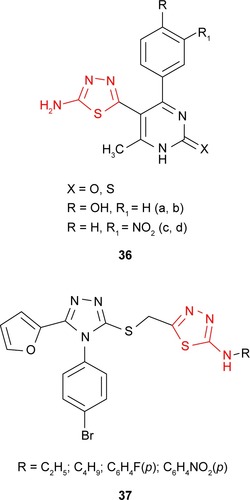
Onkol et alCitation91 have synthesized several 2-[[1(2H)-phthalazi-none-2-yl]methyl/ethyl]-5-arylamino-1,3,4-thiadiazole derivatives such as 38. The antimicrobial studies showed that the compounds are active against B. subtilis strains and two yeast-like fungi: C. albicans and Candida parapsilosis. Even if the antimicrobial activity was lower compared to the standard drugs, ampicillin and fluconazole, the tested compounds could be good starting materials for better antibacterial and antifungal agents. A number of 1-[1,3,4-thiadiazol-2-yl]-3-methylthio-6,7-dihydrobenzo[c]thiophen-4(5H)ones 39 have been evaluated for antimicrobial activity against several bacterial and fungal strains. The compounds exhibited antifungal activity against C. albicans and high potency against B. subtilis. The presence of a bulky group increased the antimicrobial activity. Thus, p-nitrophenyl derivative 39d had the same potency as nitrofurantoin against B. subtilis strains.Citation92
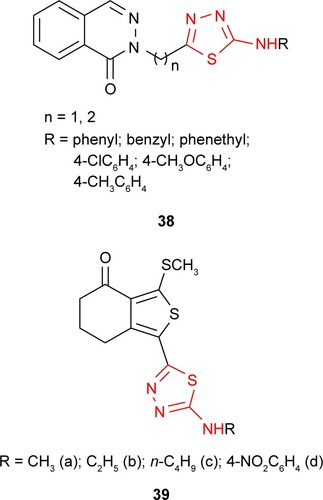
Siddiqui and AlamCitation93 and Siddiqui et alCitation94 have synthesized some new 5-(1H-indol-3-ylmethyl)-N-(substituted phenyl)-1,3,4-thiadiazol-2-amine derivatives such as 40. The antibacterial and antifungal studies showed good to high activity against E. coli and C. albicans, respectively, for some of the analyzed compounds.
Vasoya et alCitation95 reported the synthesis and antimicrobial screening of new 2-(3′-chloro-5′-phenoxybenzo[b]thiophen-2′-yl)-5-arylamino-1,3,4-thiadiazole derivatives such as 41. Upon the evaluation of antimicrobial activity, it has been found that almost all compounds exhibited antimicrobial activity against E. coli, Bacillus megaterium, S. aureus or A. niger at a concentration of 40 μg/mL. The activity was comparable or higher than the reference drugs such as benzylpenicillin, amoxicillin, ciprofloxacin, erythromycin and griseofulvin. The findings revealed that antimicrobial activity was diminished by the introduction of the electron-donating groups (eg, methyl and methoxy) on C-2 of the arylamino group.
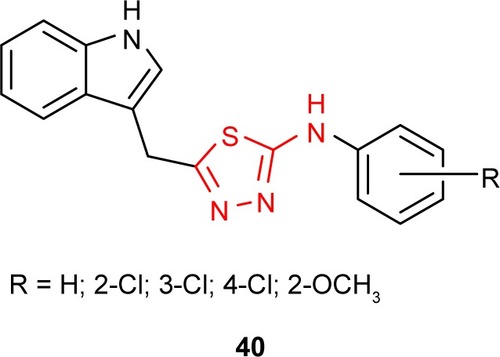
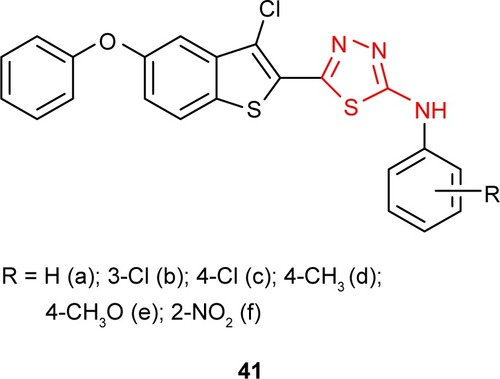
Other chlorobenzothiophene derivatives bearing the N-imidazolylthiadiazolylamine moiety were investigated for their antimicrobial activity. The benzimidazole derivative 42 showed marked antifungal activity against A. niger, while the 4,5-dihydroimidazol derivative 43 showed moderate antibacterial activity against B. cereus.Citation96
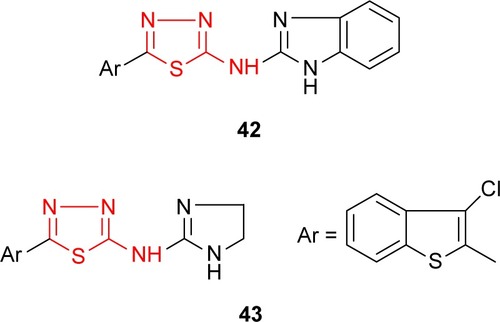
2-(3′,5′-Dichlorobenzo[b]thiophen-2′-yl)-5-arylamino-1,3,4-thiadiazole derivatives 44 exhibited antimicrobial activity against bacterial and fungal strains. The SAR study showed that the arylamino substituent at C-5 of the thiadiazole ring can change the antimicrobial spectrum. Thus, the nitro derivative 44c exhibited activity against S. aureus similar to benzylpenicillin, the o-tolylamino derivative 44a was as active as amoxicillin against Gram-negative bacteria E. coli and Proteus vulgaris, while the p-tolylamino derivative 44b exhibited antifungal activity against A. niger.Citation97

Amir et alCitation39 have synthesized new 2-R-5-(6′-chloro-1′,3′-benzo[d]thiazol-2-yl-amino)-1,3,4-thiadiazoles 45, and the antimicrobial activity has been evaluated. The compounds having 2-acetoxyphenyl (45a), 2-naphtylmethyl (45b) and 2,4-dichlorophenyl (45c) groups at C-2 of thiadiazole ring showed potent antibacterial activity, while the compounds having 2-aminophenyl (45d) and 2,4-dichlorophenoxymethyl (45e) groups showed potent antifungal activity. New 1,3,4-thiadiazole derivatives such as 46 incorporating a fluorobenzothiazole moiety have been synthesized by Vedavathi et al. The antimicrobial screening showed significant antibacterial and antifungal activity for some of the studied compounds (eg, morpholine and piperazine derivatives).Citation55,Citation98
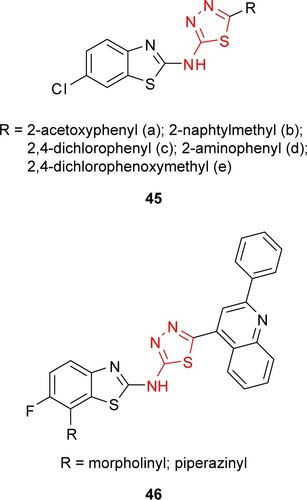
1,3,4-Thiadiazole derivatives 47, 48 and 49 bearing benzimidazole (47), benzoxazole (48) and benzothiazole (49) moiety, respectively, were screened for antibacterial activity against E. coli and Bacillus cirrhosis and antifungal activity against A. niger and Penicillium worthmanni. In comparison to norfloxacin and griseofulvin, all the tested compounds exhibited moderate to good antibacterial and antifungal activities at a concentration of 100 μg/mL. It should be noted that pyridine-substituted compounds 47b, 48b and 49b were more active at every concentration (100, 50 and 25 μg/mL) than benzyl-substituted compounds. Among the three reported heterocyclic systems, the benzimidazole derivatives such as 47 have shown better antimicrobial activity.Citation99
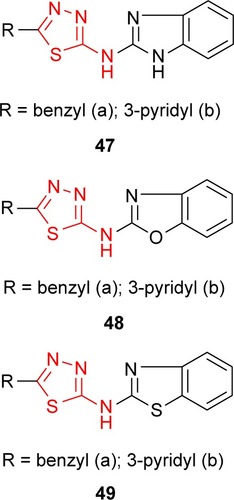
The synthesis of new polymers derived from poly(vinyl chloride) (PVC) was carried out by Yousif et al.Citation100 The modified PVC polymers 50 contain 1,3,4-thiadiazole ring and were obtained through the chlorine displacement reaction from PVC with heterocyclic moiety. The preliminary screening for the antimicrobial activity of the polymers was performed on three bacterial strains: S. aureus, Streptococcus viridans and E. coli and three fungal strains: Fusarium oxysporum, Alter-naria alternata and Alternaria solani with promising results.
8-Hydroxyquinoline derivatives, such as nitroxoline and chlorquinaldol, are well-known antimicrobial agents used for the treatment of urinary and intestinal infection, respectively. A new series of metal chelates of 5-[4-chlorophenyl-(1,3,4-thiadiazol)-2-ylaminomethylene]-8-hydroxyquinoline derivative 51 was synthesized by Patel and Singh.Citation101 The anti-fungal activity of the ligand and its transition metal chelates were evaluated. The findings suggested that the chelates are more toxic compared to the ligand. Cu2+ chelate 51a was the most active among the studied compounds.
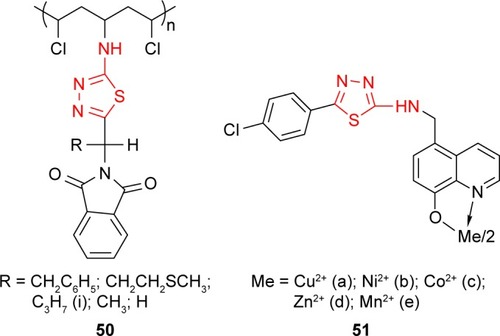
The in vitro activity of 1,3,4-thiadiazole derivatives 52 bearing an imidazo[2,1-b]thiazole moiety has been evaluated against bacterial strains of S. aureus, P. aeruginosa and E. coli and fungal strains of C. albicans, C. parapsilosis, Candida krusei, T. mentagrophytes, Trichophyton tonsurans and M. gypseum. The ethyl derivative 52b showed the highest activity against E. coli, and both methyl (52a) and ethyl (52b) derivatives were very active against T. tonsurans.Citation102
Hybrid molecules 53 incorporating a fluoroquinolone moiety and the thiadiazole ring have been synthesized, and the antimicrobial activity was investigated. The screening data revealed that the tested compounds showed moderate to excellent antibacterial and antifungal activity. Thus, the phenyl derivative 53a was more active against A. niger than nystatin, and the tolyl derivative 53b was more active against P. aeruginosa than chloramphenicol. Compared to the known antibacterial fluoroquinolones, the hybrid compounds 53a-b showed a very narrow antimicrobial spectrum.Citation103

The hybrid derivatives 54 having the 1,3,4-thiadiazole ring attached to the antipyrine moiety showed weak inhibitory activity against Gram-positive bacteria S. aureus and B. subtilis and no activity against some Gram-negative bacteria.Citation104 However, the introduction of a third heterocyclic nucleus in the structure of some hybrid antipyrine derivatives gave the compounds such as 55 with very good antimicrobial activity against enteric bacteria such as E. coli, Enterobacter aerogenes and Y. pseudotuberculosis and Gram-negative bacteria P. aeruginosa (inhibition zone >20 mm at 5 μg/mL). The most active derivative 55a was two times more active than ampicillin.Citation105
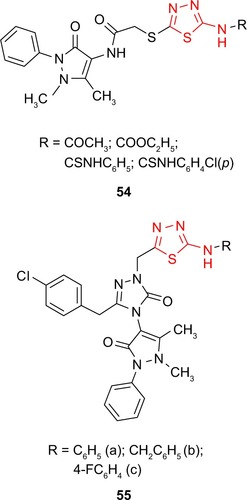
Hybrid sulfonamide-1,3,4-thiadiazole derivatives such as 56, combining two pharmacologically active molecules in one new compound, have been synthesized by Camoutsis et al.Citation106 The antimicrobial study against Gram-positive bacteria, Gram-negative bacteria and fungi has revealed some differences depending on the nature of the substituents. The relationships between the structure and the antimicrobial activity showed that pyrrolidine, piperidine and methylpiperazine derivatives are more active, the pyrrolidine derivative 56a exhibits the best antibacterial activity and the methylpiperazine derivative 56c exhibits the best antifungal activity. Moreover, the SAR study showed that the inhibitory effect depends on the substitution at the phenylamino group. Thus, substitution at the para position of the benzene ring with the CF3 group or chlorine improved the antimicrobial activity which indicates that the antimicrobial activity is correlated with the lipophilicity of the compounds expressed by the calculated values of ClogP.
Hybrid coumarin-1,3,4-thiadiazole derivatives such as 57 have been synthesized by Serban et al,Citation107–Citation109 and the antimicrobial activity has been investigated. The preliminary results of antimicrobial activities indicated that some compounds exhibited moderate to good antibacterial and antifungal activity with a narrow antimicrobial spectrum limited to P. vulgaris, P. aeruginosa and C. albicans. Except the 3-[5-(4-methylphenylamino)-1,3,4-thiadiazol-2-yl]-6-nitrocoumarin derivative 57h, which had no activity against the bacterial and fungal strains, all the tested compounds showed good activity against P. aeruginosa at a concentration of 50 μg/disk (inhibition zone of 19–22 mm), which indicates that the coumarin-1,3,4-thiadiazole system might be a promising scaffold for new antibacterial agents. In addition, the introduction of a nitro group on the coumarin ring improved the antibacterial activity against P. vulgaris (compounds 57g and 57k, inhibition zone >16 mm), while the coumarin derivatives without the nitro group showed moderate antifungal activity against C. albicans (compounds 57b, 57e and 57f, inhibition zone >12 mm). All the tested compounds were inactive against S. aureus, E. coli and K. pneumoniae.

Antitubercular activity
The treatment of infections caused by Mycobacterium tuberculosis strains has rapidly become a health problem due to the increasing resistance of bacteria to common antitubercular drugs. Moreover, the multidrug-resistant tuberculosis (MDR-TB) coupled with the increasing overlap of the AIDS and tuberculosis pandemics have brought tuberculosis among the major worldwide health problems. The development of new classes of antitubercular drugs containing a core of 2-amino-1,3,4-thiadiazole moiety is a very challenging task to many scientists.
Antibacterial quinolones became interesting medicines because of the broad antibacterial spectrum on both Gram-positive and Gram-negative bacteria. Fluoroquinolone derivatives have been introduced in therapy since 1980s and have multiple recommendations, some of them (eg, gatifloxacin, sparfloxacin and moxifloxacin) being also used in tuberculosis treatment in the cases involving resistance or intolerance to first-line antituberculosis therapy.Citation110,Citation111
A new class of antibacterial fluoroquinolones is represented by sulfonyl-fluoroquinolones which are hybrid molecules incorporating a sulfonamide moiety and a fluoroquinolone ring. Sulfonyl-fluoroquinolones are particularly active against Gram-positive bacteria. Thus, Talath and GadadCitation112 have synthesized several 7-[4-(5-amino-1,3,4-thiadiazol-2-sulfonyl)piperazin-1-yl]fluoroquinolone derivatives such as 58. The unsubstituted cyclopropyl 58a and ethyl 58b derivatives showed moderate activity against M. tuberculosis strain H37Rv at MIC of 10 μg/mL with respect to reference drug, isoniazid. The studied compounds showed antibacterial activity against other Gram-positive bacteria (S. aureus, E. faecalis, Bacillus sp., MIC =1–5 μg/mL) better than the reference fluoroquinolones (ciprofloxacin, norfloxacin, sparfloxacin and gatifloxacin) and almost similar activity as reference drugs against Corynebacterium sp. The best activity was exhibited by the derivatives 58c and 58d, which were active against all the tested Gram-positive bacteria (MIC =1–5 μg/mL). All derivatives exhibited poor activity against Gram-negative bacteria. These results are in agreement with some earlier reports which showed that substitution with aryl/heteroaryl groups at C-7 of fluoroquinolone ring is responsible for distinguishing between antibacterial activity against Gram-positive and Gram-negative bacteria.Citation112–Citation114 The reason might be differences in the structure of the cell wall of Gram-positive bacteria and Gram-negative bacteria. The cell walls of the Gram-positive bacteria contain peptidoglycan and bacterium may or may not be surrounded by a polysaccharide envelope. The cell walls of the Gram-negative bacteria contain lipopolysaccharides. The attack site of anti-cell wall agents is the peptidoglycan layer which is essential for the survival of bacteria. The damage of this layer leads to changes in the bacterial cell wall resulting in death.Citation115 In the case of compounds such as quinolones, which act as antibacterial agents by different mechanism, the structure of the cell wall is still important. The peptidoglycan layer of the Gram-positive bacteria allows the hydrophobic compounds to cross the cell wall and penetrate into the cell, while the lipopolysaccharides of the Gram-negative bacteria repel the hydrophobic compounds. The impermeable cell wall makes the Gram-negative bacteria more resistant to large or intensively hydrophobic molecules.Citation6
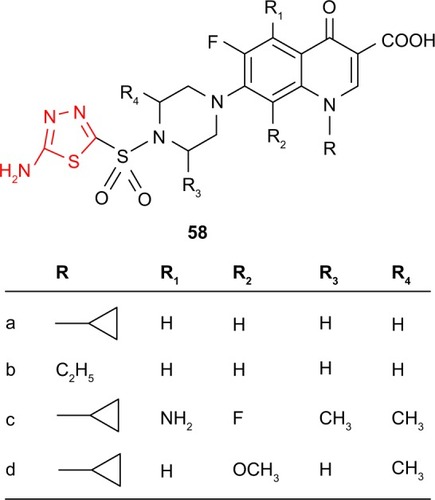
New α-[5-(5-amino-1,3,4-thiadiazol-2-yl)-imidazol-2-ylthio] acetic acid derivatives such as 59 were in vitro evaluated for antitubercular activity against M. tuberculosis strain H37Rv. Compared to standard drug, rifampicin, the tested compounds exhibited low activity (MIC ≥6.25 μg/mL, inhibition ≤24%), but they might be considered as good starting compounds for better antitubercular agents.Citation116 In comparison, the dichlorobenzothiophene thiadiazole 44c exhibited very high activity against M. tuberculosis strain H37Rv in BACTEC 12B medium (98% inhibition) at the concentration of 6.25 μg/mL.Citation97
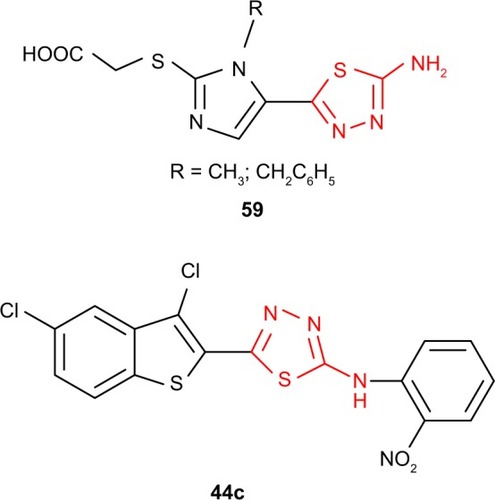
Karakus and RollasCitation117 have synthesized new N-phenyl-N′-[4-(5-alkyl/arylamino-1,3,4-thiadiazol-2-yl)phenyl]thio-ureas 60. Using BACTEC 460 radiometric system (Becton Dickinson, Cockeysville, MD, USA), the in vitro activity against M. tuberculosis strain H37Rv at 6.25 μg/mL has been studied. Compared to standard drug, rifampicin, the best inhibitory activity (67%) was shown by the derivative 60a having a cyclohexyl group, while the derivative 60b having a p-chlorophenyl group showed 32% inhibition against M. tuberculosis. Other derivatives exhibited different degrees of inhibition (16% for compound 60c, 6% for compound 60d).
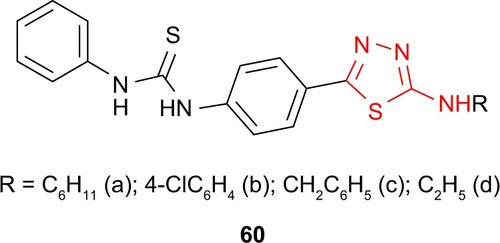
Similarly, 2-amino-5-R-1,3,4-thiadiazole derivatives such as 61 were investigated for antitubercular activity. Among the tested compounds, 2-phenylamino-5-(4-fluorophenyl)-1,3,4-thiadiazole 61e showed the best inhibitory activity (69%), while 2-phenylamino-5-phe-nyl-1,3,4-thiadiazole 61a showed 65% inhibitory activity against in vitro growing M. tuberculosis H37Rv at a concentration of 6.25 μg/mL. Other studied molecules were classified as high activity compounds (28 derivatives, inhibition activity ≥35%), and this structure may be considered a good scaffold for the development of new antituberculosis agents. The electronic topological method (ETM) and feed-forward neural networks (FFNNs), which were used for the structure–antituberculosis activity relationship study, gave a system of pharmacophores and anti-pharmacophores able to separate the examined compounds in active and inactive compounds. According to these methods, low-activity molecules form a buffer zone consisting of compounds that can include both pharmacophores and anti-pharmacophores.Citation42

The antimycobacterial activity against M. tuberculosis of 1,3,4-thiadiazole derivatives bearing an imidazo[2,1-b] thiazole moiety has been evaluated, the most active compound being the phenylamino derivative 62 (16% inhibition, MIC >6.25 μg/mL).Citation102 Vasoya et alCitation95 have reported the antitubercular activity against M. tuberculosis of some 2-(3′-chloro-5′-phenoxybenzo[b]thiophen-2′-yl)-5-arylamino-1,3,4-thiadiazole derivatives such as 41. In comparison to the antimicrobial screening of the same compounds, the derivatives bearing the electron-donating groups (eg, methyl and methoxy) at C-2 and C-4 of the arylamino group showed higher activity, the most active compound being 2-(3′-chloro-5′-phenoxybenzo[b]thiophen-2′-yl)-5-(p-methoxyphenyl) amino-1,3,4-thiadiazole 41e (91% inhibition at the concentration of 6.25 μg/mL).
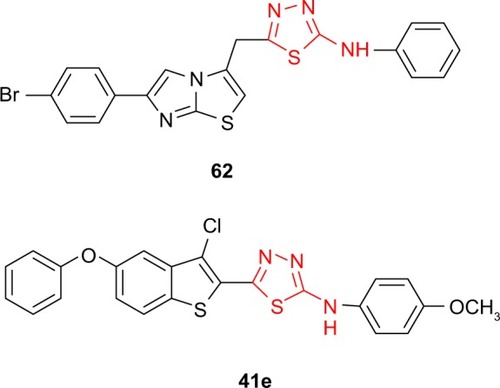
New N-[5-(1-amino-2-phenylethyl)-1,3,4-thiadiazol-2-yl]-6-fluoro-7-substituted 1,3-benzothiazol-2-amine derivatives such as 63 have been in vitro evaluated for antitubercular activity against M. tuberculosis strain H37Rv. The compounds showed promising antitubercular activity in comparison to standard drugs, rifampicin and isoniazid.Citation118 Bayrak et alCitation105 hybridized antipyrine with 1,3,4-thiadiazole and 1,2,4-triazole rings, getting the compounds such as 55. Even if the synthesized compounds were completely inactive against Gram-positive microorganisms such as S. aureus, E. faecalis or B. cereus, the studied compounds exhibited good inhibitory activity (inhibition zone of 25 mm at 5 μg/mL) against Mycobacterium smegmatis which is an atypical factor of tuberculosis.

Other hybrid molecules incorporating the 1,3,4-thiadiazole ring and benzimidazole (47), benzoxazole (48) and benzothiazole (49) moiety were screened for in vitro antitubercular activity against M. tuberculosis H37Rv strain using the microplate Alamar blue assay (MABA). Compounds demonstrating at least 90% inhibition in preliminary screening were further evaluated to determine the MIC. All the compounds exhibited inhibitory activity against M. tuberculosis with a rate of inhibition between 53% and 95% at a concentration of 6.25 μg/mL. Out of all heterocyclic derivatives, the benzoxazole derivatives such as 48 have shown the best inhibitory activity (93% for 48a and 95% for 48b), while the benzimidazole derivatives such as 47 have shown the moderate inhibitory activity (77% for 47a and 74% for 47b).Citation99
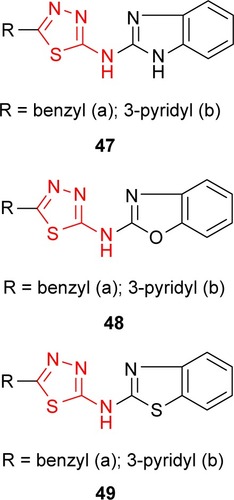
Some thiadiazole derivatives designed as M. tuberculosis inhibitors were tested using BACTEC 460 radiometric system. The antitubercular activity of 2-(alkyl/arylamino)-5-(4-aminophenyl)-1,3,4-thiadiazoles 64 was compared to those of the Schiff bases 65 obtained by the condensation of the starting thiadiazoles with aromatic and heterocyclic aldehydes. Some Schiff bases synthesized from salicylal-dehyde and 3-nitrobenzaldehyde and bearing an arylamino group at C-2 of thiadiazole ring were more active than the starting thiadiazoles (eg, compounds 65c-f). All the Schiff bases having an alkylamino group at C-2 of thiadiazole ring were less active than the starting thiadiazoles (compounds 65a-b). 2-Phenylamino-5-[4-(2-hydroxybenzylideneamino) phenyl]-1,3,4-thiadiazole 65c showed the highest inhibition (51%, MIC >6.25 μg/mL),Citation119 which is in agreement with other studies indicating that the conjugation of hydroxyl ligand with the imine group synergistically enhances the antimycobacterial activity.Citation120

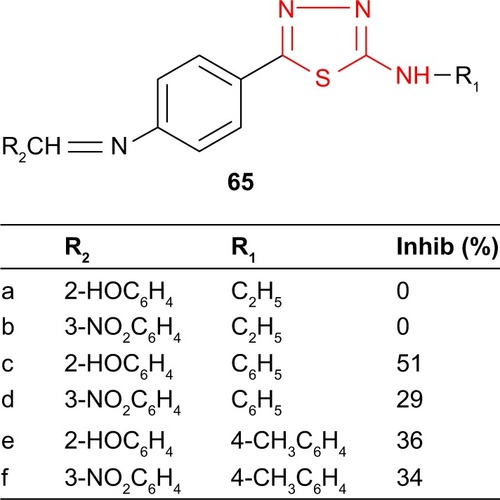
Starting from L-methionine, Tatar et alCitation121 synthesized different phenylamino-1,3,4-thiadiazole derivatives. 1,3,4-Thiadiazole benzamide 66 and 1,3,4-thiadiazole thiourea 67 exhibited antimycobacterial activity against M. tuberculosis H37Rv strain with MIC values of 79.50 and 61.77 μM, respectively. Unfortunately, the compounds proved low selectivity with minimum cytotoxic concentration (MCC) values lower than MIC values.
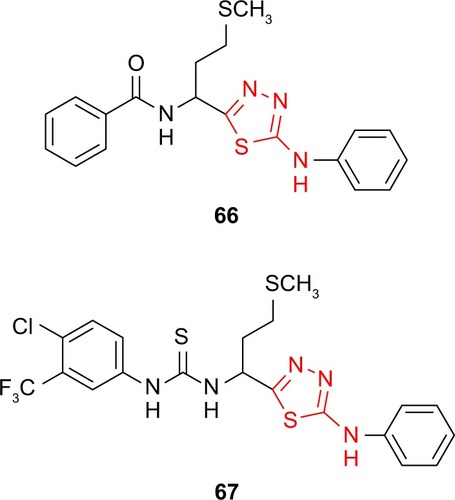
Fungicidal and herbicidal activities
The fungicidal activity of thiadiazole derivatives against A. niger and Harpophora oryzae and their potential application as pesticides in agriculture has been previously reported.Citation122,Citation123 Some sulfide, sulfoxide and sulfonamide thiadiazoles were also reported for their fungicidal activity against Gibberella zeae, Botrytis cinerea, Sclerotinia sclerotiorum, F. oxysporum or Cytospora mandshurica.Citation6 In this connection, various derivatives containing 2-amino-1,3,4-thiadiazole system have been prepared. 2-Arylamino-5-glycosyl-1, 3,4-thiadiazole derivatives such as 68 were synthesized by Zong et al,Citation124 and the fungicidal activity against six fungal species: S. sclerotiorum, Phytophthora parasitica, B. cinerea, Rhizoctonia solani, Pyricularia oryzae and Phoma asparagi was in vitro investigated. Most of the 20 studied compounds displayed good fungicidal activities against S. sclerotiorum (12 compounds with inhibition rate of ≥85%) and P. oryzae (seven compounds with inhibition rate of ≥80%) at a concentration of 50 μg/mL. Further studies against S. sclerotiorum at the concentrations of 50, 20, 10, 5 and 2 μg/mL were used to determine the effective concentration values EC50. About half of the studied compounds displayed good fungicidal activity with EC50 <3 μg/mL. The SAR studies showed that the compounds with two electron-withdrawing groups at the benzene ring exhibited the best fungicidal activity. Thus, compounds 68b (EC50 =0.29 μg/mL) and 68j (EC50 =0.46 μg/mL) are comparable with the commercial fungicide, chlorothalonil. In comparison, the compounds with two electron-donating groups at the benzene ring, such as 68a and 68f, displayed only moderate fungicidal activity. Furthermore, SAR studies revealed the importance of the hydroxyl protecting group in the sugar ring. Thus, the compounds without any hydroxyl group protection in the sugar ring displayed moderate to significant decrease in their fungicidal activity. In addition, the allyl protecting group was more efficient for the fungicidal activity compared to the acetyl protecting group. In general, the allyl derivatives displayed better fungicidal activity against the six fungal species than the acetyl derivatives (eg, 68c and 68h, 68d and 68i and 68e and 68j).Citation124
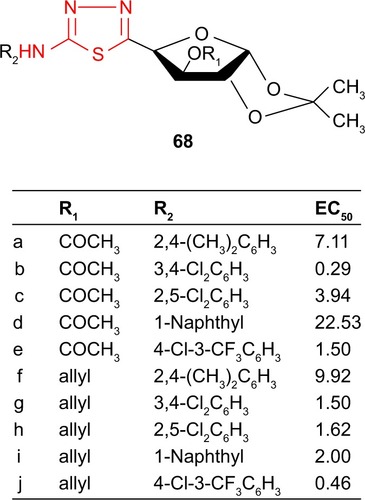
Yadav et alCitation125 have synthesized 2-amino-5-substituted-1,3,4-thiadiazoles 69, and the in vitro fungicidal activity against P. oryzae and R. solani at 500 ppm was investigated. Fungicidal screening data indicated a moderate activity compared to the reference fungicide, carbendazim, the tested compounds being more active against P. oryzae than R. solani. The nature and the position of the substituents of the phenyl ring significantly changed the biological activity. Among the tested compounds, the chlorosubstituted derivatives 69a, 69b and 69d have shown greater activity (P. oryzae inhibition rate between 32% and 42%) than the methylated ones (eg, 69c, P. oryzae inhibition rate of 16%), the para chlorinated compound 69a being the most active. Methylation of the p-chloroderivative decreased the activity on both fungi.
Chu et alCitation126 have synthesized several ω-(5-arylamino-1,3,4-thiadiazol-2-thio)-ω-(1H-1,2,4-triazol-1-yl)aceto-phenone derivatives such as 70 which exhibited, at a concentration of 50 ppm, fungicidal activity against some pathogenic fungi of plants such as leaf rust of barley, leaf spot of beet, early blight of tomato, gray mold of cucumber and sclerotium blight of colza with an inhibition rate between 5% and 66.6%. Chemical modification of these structures might give good fungicidal agents for agriculture.
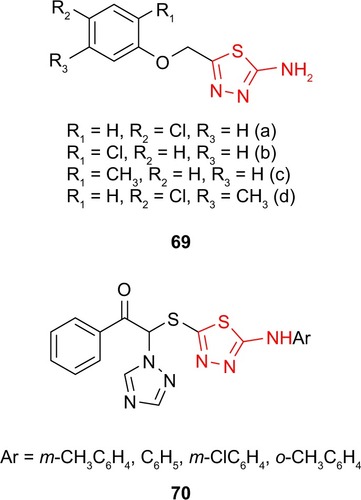
In addition, pyridazinone-substituted 1,3,4-thiadiazoles 71 synthesized by Zou et alCitation127,Citation128 were tested for in vivo antifungal activity against wheat leaf rust, Puccinia recondita, at a concentration of 0.001 M solution in water/dimethylformamide. Some derivatives showed high inhibitory activity (80%–90%) compared to the commercial fungicide, triadimefon (100% inhibition). A quantitative SAR (QSAR) study showed that the increase in the hydrophobicity of R2 leads to an increased fungicidal activity (m-CF3 > o-F > H). Concerning the substituent R1, the best and consistent results were obtained in the cases of ortho substituents with inductive electron-donating properties. The preferred substituent for R1 was the 2,4-dimethyl group, as can be seen with compounds 71d and 71e.
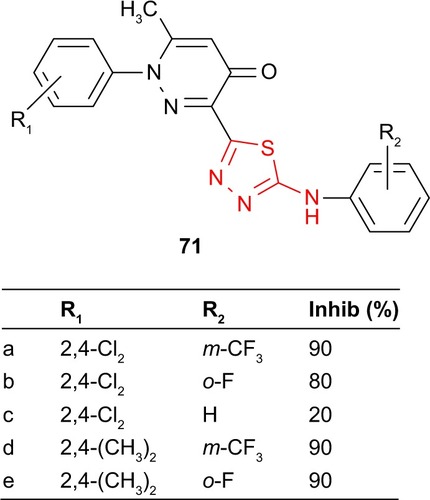
Conclusion
Thiadiazole ring is present in compounds with various biological activities. Among the different isomers of thiadiazole, 1,3,4-thiadiazole derivatives are most studied due to broad spectrum of pharmacological activities. Although only a few pharmacological effects exhibited by 1,3,4-thiadiazole derivatives are currently clinically used (eg, antibacterial activity and carbonic anhydrase inhibiting activity), the substitution at thiadiazole ring is a challenging approach to obtain agents with improved potency and less toxicity.
The cytostatic properties of 2-amino-1,3,4-thiadiazole and the anti-trypanosomal properties of megazol are evidence of the biological potential of the 2-amino-1,3,4-thiadiazole moiety. Literature surveys report the antimicrobial activity of substituted 2-amino-1,3,4-thiadiazoles, making 2-amino-1,3,4-thia-diazole a unique template with significant utility in medicinal chemistry. Many 2-amino-1,3,4-thiadiazole derivatives can be considered as lead compounds for drug development. The SAR studies revealed that the antimicrobial activity is dependent on the nature of the substituents at the thiadiazole nucleus.
Although the antibacterial, antifungal and antitubercular properties are the main antimicrobial activities studied, other antimicrobial activities exhibited by 2-amino-1,3,4-thiadiazole derivatives are also explored. Many derivatives have shown good antimicrobial activities with good in vitro experimental results but deficient in vivo experimental data, suggesting that the mechanism of action is not clear and further studies are needed.
Disclosure
The authors report no conflicts of interest in this work.
References
- WermuthCGCiapettiPGiethlenBBazziniPBioisosterismComprehensive Medicinal Chemistry2TaylorJBTriggleDJAmsterdamElsevier2007649711
- HollaBSPoorjaryKNRaoBSShivanandaMKNew bis-aminomercaptotriazoles and bis-triazolothiadiazoles as possible anticancer agentsEur J Med Chem20023751151712204477
- YousifEMajeedAAl-SammarraeKSalihNSalimonJAbdullahBMetal complexes of Schiff base: preparation, characterization and antibacterial activityArabian J Chem20135S210.1016/j.arabjc.2013.06.006
- LiYGengJLiuYYuSZhaoGThiadiazole – a promising structure in medicinal chemistryChemMedChem201381274123208773
- WermuthCGAldousDRaboissonPRognanDThe Practice of Medicinal Chemistry4th edLondonAcademic Press, Elsevier2015196
- HuYLiCYWangXMYangYHZhuHL1,3,4-Thiadiazole: synthesis, reactions and applications in medicinal, agricultural, and materials chemistryChem Rev2014114105572561024716666
- BrownNBioisosteres in Medicinal ChemistryWeinheim, GermanyWiley-VCH Verlag and Co., KGaA2012
- TripathyRGhoseASinghJ1,2,3-Thiadiazole substituted pyrazolones as potent KDR/VEGFR-2 kinase inhibitorsBioorg Med Chem Lett20071761793179817239587
- WermuthCGAre pyridazines privileged structures?Med Chem Commun20112935941
- BiziereKWormsPKanJPMandelPGarattiniSRoncucciRMinaprine, a new drug with antidepressant propertiesDrugs Exp Clin Res198511128318403836113
- UenoSBracamontesJZorumskiCWeissDSSteinbachJHBicuculline and gabazine are allosteric inhibitors of channel opening of the GABA A receptorJ Neurosci19971726256348987785
- Senff-RibeiroAEchevarriaASilvaEFFrancoCRCVeigaSSOliveiraMBMCytotoxic effect of a new 1,3,4-thiadiazolium mesoionic compound (MI-D) on cell lines of human melanomaBr J Cancer200491229730415199390
- FosbinderRJWalterLASulfanilamido derivatives of heterocyclic aminesJ Am Chem Soc193961820322033
- LottWABergeimFH2-(p-Aminobenzenesulfonamido)-thia zole: a new chemo therapeutic agentJ Am Chem Soc19396135933594
- TappiGHeterocyclic derivatives of sulfanilamideRecl Trav Chim194362207209
- MasakiOMifuneAHigashijimaTNagatoS1,3,4-Thiadiazole derivatives. Several reactions of aminothiadiazolesJ Pharm Soc Jpn195171481484
- FriskARSulfanilamide derivatives, chemotherapeutic evaluation of N1-substituted sulfonamideActa Med Scand Suppl19431421
- BealeJMBlockJHWilson and Gisvold’s Textbook of Organic Medicinal and Pharmaceutical Chemistry12th edPhiladelphiaLippincott Williams and Wilkins, Wolters Kluwer2011238
- RoblinROClappJWCarbonic anhydrase inhibitorJ Am Chem Soc1950724890
- ClappJWRoblinROUS Patent25548161951
- Chem Abstr1952463087
- SeldinDGiebischGDiuretic Agents: Clinical Physiology and PharmacologySan DiegoAcademic Press199724
- LemkeTLWilliamsDARocheVFZitoSWFoye’s Principles of Medicinal Chemistry7th edPhiladelphiaLippincott Williams and Wilkins, Wolters Kluwer2013735
- Medindex [homepage on the Internet] Available from: http://medin-dex.am/glossary/index.php/term/UMLS.+CSP-HL7-ICD9CM-NCI-NDFRT-RXNORM,METHAZOLAMIDE.xhtmlAccessed March 7, 2017
- OlsenJJSlobodaATroyWPThe carcinostatic activity of some 2-amino-1,3,4-thiadiazolesJ Am Chem Soc19557767136714
- BerkelhammerGAsatoG2-Amino-5-(1-methyl-5-nitro-2-imidazolyl)-1,3,4-thiadiazole: a new antimicrobial agentScience196816238581146
- Marie-DaragonARouillardMCBouteilleBBisserSde AlbuquerqueCAn efficacy trial on Trypanosoma brucei of molecules permeating the blood-brain barrier and of megazolBull Soc Pathol Exot19948753473527496199
- BouteilleBMarie-DaragonAChauviereGde AlbuquerqueCEnangaBEffect of megazol on Trypanosoma brucei acute and subacute infections in Swiss miceActa Trop199560273808610542
- NesslanyFBrugierSMouriesMALe CurieuxFMarzinDIn vitro and in vivo chromosomal aberrations induced by megazolMutat Res2004560214715815157652
- EnangaBAriyanayagamMRStewartMLBarrettMPActivity of megazol, a trypanocidal nitroimidazole, is associated with DNA damageAntimicrob Agents Chemother200347103368337014506061
- de Silva CarvalhoASalomaoKde CastroSLMegazol and its bioisostere 4H-1,2,4-triazole: comparing the trypanocidal, cytotoxic and genotoxic activities and their in vitro and in silico interactions with the Trypanosoma brucei nitroreductase enzymeMem Inst Oswaldo Cruz2014109331532324676659
- ChauviereGBouteilleBEnangaBSynthesis and biological activity of nitro heterocycles analogous of megazol, a trypanocidal leadJ Med Chem200346342744012540242
- NishidaMMatsubaraTMurakawaTMineYYokotaYKuwaharaSIn vitro and in vivo evaluation of cefazolin, a new cephalosporin C derivativeAntimicrob Agents Chemother (Bethesda)196992362435396493
- NishidaMMatsubaraTMurakawaTMineYYokotaYCefazolin, a new semisynthetic cephalosporin antibiotic. II. In vitro and in vivo antimicrobial activityJ Antibiot (Tokyo)19702331371484394125
- KusabaTSafety and efficacy of cefazolin sodium in the management of bacterial infection and in surgical prophylaxisClin Med Insights Ther2009116071615
- SaginurRCroteauDBergeronMGComparative efficacy of teicoplanin and cefazolin for cardiac operation prophylaxis in 3027 patients. The ESPRIT GroupJ Thorac Cardiovasc Surg200012061120113011088036
- MakiDGBohnMJStolzSMKronckeGMAcherCWMyerowitzPDComparative study of cefazolin, cefamandole and vancomycin for surgical prophylaxis in cardiac and vascular operations. A double-blind randomized trialJ Thorac Cardiovasc Surg19921045142314341434726
- FinkelsteinRRabinoGMashiahTVancomycin versus cefazolin prophylaxis for cardiac surgery in the setting of a high prevalence of methicillin-resistant staphylococcal infectionsJ Thorac Cardiovasc Surg2002123232633211828293
- BolonMKMorloteMWeberSGKoplanBCarmeliYWrightSBGlycopeptides are no more effective than beta-lactam agents for prevention of surgical infection after cardiac surgery: a meta-analysisClin Infect Dis200438101357136315156470
- AmirMKumarAAliIKhanSASynthesis of pharmaceutically important 1,3,4-thiadiazole and imidazolinone derivatives as antimicrobialsIndian J Chem200948B12881293
- DesaiKBaxiAJStudies on 2-azetidinone: part VI synthesis and antimicrobial activity of 5-(2′,4′-dichlorophenoxymethyl)-2-(4″-aryl-3″-chloro-2″-azetidinone-1″-yl)-1,3,4-thiadiazoleIndian J Pharm Sci199254183188
- SalimonJSalihNHameedAIbraheemHYousifESynthesis and antibacterial activity of some new 1,3,4-oxadiazole and 1,3,4-thiadiazole derivativesJ Appl Sci Res201067866870
- OrucEERollasSKandemirliFShvetsNDimogloA1,3,4-Thiadiazole derivatives. Synthesis, structure elucidation and structure-antituberculosis activity relationship investigationJ Med Chem200447276760676715615525
- BoninaLIannelloDMerendinoRArenaAMastroeniPTumor-dependent resistance of rat peritoneal macrophages to herpes simplex virusDrugs Exp Clin Res19839577583
- SchenoneSBrulloCBrunoONew 1,3,4-thiadiazole derivatives endowed with analgesic and anti-inflammatory activitiesBioorg Med Chem20061461698170516310359
- ClericiFPocarDGuidoMLocheAPerliniVBrufaniMSynthesis of 2-amino-5-sulfanyl-1,3,4-thiadiazole derivatives and evaluation of their antidepressant and anxiolytic activityJ Med Chem200144693193611300875
- TurnerSMyersMGadieBAntihypertensive thiadiazoles. 2. Vasodilator activity of some 2-aryl-5-guanidino-1,3,4-thiadiazolesJ Med Chem1988315907913
- LabanauskasLKalcasVUdrenaiteEGaidelisPBrukstusADauksasASynthesis of 3-(3,4-dimethoxyphenyl)-1H-1,2,4-triazole-5-thiol and 2-amino-5-(3,4-dimethoxyphenyl)-1,3,4-thiadiazole derivatives exhibiting anti-inflammatory activityPharmazie200156861761911534336
- PattanSRDesaiNSRabaraPABukitgarAAWakaleVASynthesis and antimicrobial evaluation of some 1,3,4-thiadiazole derivativesIndian J Pharm Ed Res2008424314318
- MazzoneGPignatelloRMazzoneSSynthesis and local anesthetic activity of alkylaminoacyl derivatives of 2-amino-1,3,4-thiadiazoleFarmaco1993489120712248259979
- SiddiquiADaiCMansoorUYangLVitharanaLAngelesASpirocondensed 1,3,4-thiadiazole derivatives for inhibiting KSP kinesin activityWO2009/052288
- BassoALiuMDaiCSCH 2047069, a novel oral kinesin spindle protein inhibitor, shows single-agent antitumor activity and enhances the efficacy of chemotherapeuticsMol Cancer Ther20109112993300220978164
- TahaSSAhmadAAMawloodSIAliNOSynthesis of some series of 2-amino-1,3,4-thiadiazole derivatives with their pathogenic bacterial activityJ Raparin Univ20174116378
- LiuGCoganDAEllmanJACatalytic asymmetric synthesis of tert-butanesulfinamide. Application to the asymmetric synthesis of aminesJ Am Chem Soc19971194199139914
- KadiAAAl-AbdullahESShehataIAHabibEEIbrahimTMEl-EmamAASynthesis, antimicrobial and anti-inflammatory activities of novel 5-(1-adamantyl)-1,3,4-thiadiazole derivativesEur J Med Chem201045115006501120801553
- SharmaPCSinhmarASharmaARajakHPathakDPMedicinal significance of benzothiazole scaffold: an insight viewJ Enzyme Inhib Med Chem201328224026623030043
- OthmanAAKihelMAmaraS1,3,4-Oxadiazole, 1,3,4-thiadiazole and 1,2,4-triazole derivatives as potential antibacterial agentsArabian J Chem201410.1016/j.arabjc.2014.09.003
- JohnsonDSLiJJThe Art of Drug SynthesisHoboken, NJWiley-Interscience, John Wiley and Sons, Inc20074072
- FernandezLBreidensteinEBHancockRECreeping baselines and adaptive resistance to antibioticsDrug Resist Updat201114112121288762
- LemkeTLWilliamsDARocheVFZitoSWFoye’s Principles of Medicinal Chemistry7th edPhiladelphiaLippincott Williams and Wilkins, Wolters Kluwer20131159
- World Health Organization [webpage on the Internet] Available from: http://www.who.int/world-health-day/2011/en/Accessed April 21, 2018
- BhuvaHSahuDShahBNModiDCPatelMBBiological profile of thiadiazolePharmacologyonline20111528543
- UpadhyayPKMishraPSynthesis, antimicrobial and anticancer activities of 5-(4-substituted phenyl)-1,3,4-thiadiazole-2-aminesRasayan J Chem2017101254262
- HussainSSharmaJAmirMSynthesis and Antimicrobial activities of 1,2,4-triazole and 1,3,4-thiadiazole derivatives of 5-amino-2-hydroxybenzoic acidE-J Chem200854963968
- KucukguzelSGKucukguzelITatarESynthesis of some novel heterocyclic compounds derived from diflunisal hydrazide as potential anti-infective and anti-inflammatory agentsEur J Med Chem200742789390117418454
- KadiAAEl-BrolossyNRAl-DeebOAHabibEEIbrahimTMEl-EmamAASynthesis, antimicrobial, and anti-inflammatory activities of novel 2-(1-adamantyl)-5-substituted-1,3,4-oxadiazoles and 2-(1-adamantylamino)-5-substituted-1,3,4-thiadiazolesEur J Med Chem200742223524217129641
- PintilieOProfireLSunelVPopaMPuiASynthesis and antimicrobial activity of some new 1,3,4-tiadiazole and 1,2,4-triazole compounds having a D,L-methionine moietyMolecules200712110311317693957
- RadOTiborRDumaMSynthesis and antimicrobial activity of some 5-mercapto-2-amino-1,3,4-thiadiazole derivative thioethers and Schiff basesStud UBB Chem20166111732
- MatysiakJMalinskiZ2-(2,4-Dihydroxyphenyl)-1,3,4-thiadiazole analogues: antifungal activity in vitro against Candida speciesRuss J Bioorg Chem2007336594601
- RajMMPatelHVRajLMPatelNKSynthesis and biological evaluation of some new 1,3,4-thiadiazole derivatives for their antimicrobial activitiesInt J Pharm Chem Biol Sci201333814819
- ShahHVashiSMehtaSSynthesis of 2,5-disubstituted-1,3,4-oxadiazole, 1,5-disubstituted-2-mercapto-1,3,4-triazole and 2,5-disubstituted-1,3,4-thiadiazole as potential antimicrobial agentsIndian J Chem199635B111115
- NargundGVLReddyNRGHariprasadNSynthesis and antibacterial activity of a series of 1-aryl-2-mercapto-5-[4-(acetamidophenoxy)methyl]-1,3,4-thiazoles, thiadiazoles and 2-[4-acetamidophenoxy carbonyl]3,4,5-trisubstituted pyrazolesIndian J Chem199635B499502
- SahPBidawatPSethMGharuCPSynthesis of formazans from Mannich base of 5-(4-chlorophenylamino)-2-mercapto-1,3,4-thiadiazole as antimicrobial agentsArabian J Chem20147181187
- DoganHNDuranARollasSSenerGUysalMKGulenDSynthesis of new 2,5-disubstituted-1,3,4-thiadiazoles and preliminary evaluation of anticonvulsant and antimicrobial activitiesBioorg Med Chem20021092893289812110309
- FarshoriNNBandayMRAhmadAKhanAURaufASynthesis, characterization and in vitro antimicrobial activities of 5-alkenyl/hydroxyalkenyl-2-phenylamine-1,3,4-oxadiazoles and thiadiazolesBioorg Med Chem Lett20102061933193820172722
- BarboiuMCimpoesuMGuranCSupuranCT1,3,4-Thiadiazole derivatives. Part 9. Synthesis and biological activity of metal complexes of 5-(2-aminoethyl)-2-amino-1,3,4-thiadiazoleMet Based Drugs19963522723218472898
- ObaleyeJAAdedijiJFAdebayoMASynthesis and biological activities on metal complexes of 2,5-diamino-1,3,4-thiadiazole derived from semicarbazide hydrochlorideMolecules20111675861587421750479
- AshutoshBAnkurJKumarNRSynthesis, characterization and antimicrobial activity of azol substituted derivativesInt J Pharm Sci Drug Res200913207210
- RezkiNAl-YahyawiAMBardaweelSKAl-BlewiFFAouadMRSynthesis of novel 2,5-disubstituted-1,3,4-thiadiazoles clubbed 1,2,4-triazole, 1,3,4-thiadiazole, 1,3,4-oxadiazole and/or Schiff base as potent antimicrobial and antiproliferative agentsMolecules2015209160481606726364633
- HeY-WCaoL-HZhangJ-BWangD-ZAisaHASynthesis and bioac-tivity of 5-(1-aryl-1H-tetrazol-5-ylsulfanylmethyl)-N-xylopyranosyl-1-,3,4-oxa(thia)diazol-2-aminesCarbohydr Res2011346555155921353206
- ShermanWR5-Nitro-2-furyl-substituted 1,3,4-oxadiazoles, 1,3,4-thiadiazoles and 1,3,5-triazinesJ Org Chem19612618895
- DemirbasNKaraogluSADemirbasASancakKSynthesis and antimicrobial activities of some new 1-(5-phenylamino-[1,3,4]thiadiazol-2-yl)methyl-5-oxo-[1,2,4]-triazole and 1-(4-phenyl-5-thioxo-[1,2,4] triazol-3-yl)methyl-5-oxo-[1,2,4]triazole derivativesEur J Med Chem200439979380415337292
- BektasHDemirbasADemirbasNBayrakHKaraogluSASynthesis and antimicrobial activities of some new biheterocyclic compounds containing 1,2,4-triazol-3-one and 1,3,4-thiadiazole moietiesTurk J Chem201034517527
- DemirbasASahinDDemirbasNKaraogluSASynthesis of some new 1,3,4-thiadiazol-2-ylmethyl-1,2,4-triazole derivatives and investigation of their antimicrobial activitiesEur J Med Chem20094472896290319167136
- BekhitAAAshourHMAGhanyYSABekhitAEABarakaASynthesis and biological evaluation of some thiazolyl and thiadiazolyl derivatives of 1H-pyrazole as anti-inflammatory antimicrobial agentsEur J Med Chem200843345646317532544
- ZamaniKFaghihiKTofighiTShariatzadehMRSynthesis and antimicrobial activity of some pyridyl and naphthyl substituted 1,2,4-triazole and 1,3,4-thiadiazole derivativesTurk J Chem20042895100
- ZamaniKFaghihiKMehranjaniMSSynthesis of some new 2,5-disubstituted 1,3,4-thiadiazoles containing isomeric pyridyl as potent antimicrobial agentsPol J Pharmacol20035561111111714730108
- SzulczykDTomaszewskiPJozwiakMSynthesis and biological activities of ethyl 2-(2-pyridylacetate) derivatives containing thiourea, 1,2,4-triazole, thiadiazole and oxadiazole moietiesMolecules2017223409
- PatilRLMandhareNPBondgePSMundeBSManeARSynthesis and antimicrobial activity of new pyrimidine incorporated 1,3,4-thiadiazolesIndian J Heterocycl Chem200312245248
- AndrewsBKomathiKMohanSSynthesis and comparing the antibacterial activities of pyrimidine derivativesJ Chem Soc20171293335341
- KlipNTCapanGGursoyAUzunMSatanaDSynthesis, structure and antifungal evaluation of some novel 1,2,4-triazolylmercaptoacetyl thiosemicarbazide and 1,2,4-triazolylmercaptomethyl-1,3,4-thiadiazole analogsJ Enzyme Inhib Med Chem201025112613120030516
- OnkolTDogruerDSUzunLAdakSOzkanSSahinMFSynthesis and antimicrobial activity of new 1,2,4-triazole and 1,3,4-thiadiazole derivativesJ Enzyme Inhib Med Chem200823227728418343916
- TehranchianSAkbarzadehTFazeliMRJamalifarHShafieeASynthesis and antibacterial activity of 1-[1,2,4-triazol-3-yl] and 1-[1,3,4-thiadiazol-2-yl]-3-methylthio-6,7-dihydro-benzo[c]thiophen-4(5H)onesBioorg Med Chem Lett20051541023102515686905
- SiddiquiNAlamMS5-(1H-indol-3-ylmethyl)-N-(substituted phenyl)-1,3,4-thiadiazol-2-amine derivatives: synthesis and biological screeningBiosci Biotech Res Asia200961261264
- SiddiquiNAhujaPAhsanWPandeyaSNAlamMSThiadiazoles: progress report on biological activitiesJ Chem Pharm Res2009111930
- VasoyaSLPaghdarDJChovatiaPTJoshiHSSynthesis of some new thiosemicarbazide and 1,3,4-thiadiazole heterocycles bearing benzo[b]thiophene nucleus as a potent antitubercular and antimicrobial agentsJ Sci I R Iran20051613336
- AlyAAEl-SayedRSynthesis and biological activity of new 1,3,4-thiadiazole derivativesChem Pap20066015660
- ThakerKMJoshiHSSynthesis and pharmacological evaluation of 2-(3′,5′-dichlorobenzo[b]thiophen-2′-yl)-5-arylamino-1,3,4-thiadiazolesIndian J Chem200544B410412
- AhmadTSinghAKJaiswalNSinghDSynthesis and pharmacological activity of 1,3,4-thiadiazole derivatives: a reviewInt Res J Pharm2012337082
- HegdeVSKolaviGDLamaniRSKhaziIAMDimethyldithioimi-docarbonates-mediated heterocyclizations: synthesis of imidazolidines and benzheterocycles as potent antitubercular agentsPhosphorus Sulfur Silicon20071824911920
- YousifEHameedAKamilAFarinaYAsaadNGraisaASynthesis of new polymers derived from poly(vinyl chloride) and study their biological evaluationAust J Basic Appl Sci20093317861794
- PatelDSinghASynthesis, characterization and antimicrobial activity of metal chelates of 5-[4-chlorophenyl(1,3,4)thiadiazol-2-ylaminomethylene]-8-hydroxy quinolineE-J Chem20096410171022
- GuzeldemirciNUKucukbasmaciOSynthesis and antimicrobial activity evaluation of new 1,2,4-triazoles and 1,3,4-thiadiazoles bearing imidazo[2,1-b]thiazole moietyEur J Med Chem2010451636819939519
- ShelkeSMhaskeGGadakhSGillCGreen synthesis and biological evaluation of some novel azoles as antimicrobial agentsBioorg Med Chem Lett201020247200720421074427
- RostomSAFEl-AshmawyIMAbd El RazikHABadrMHAshourHMADesign and synthesis of some thiazolyl and thiadiazolyl derivatives of antipyrine as potential non-acidic anti-inflammatory, analgesic and antimicrobial agentsBioorg Med Chem200917288289519084415
- BayrakHDemirbasADemirbasNKaraogluSACyclization of some carbothioamide derivatives containing antipyrine and triazole moieties and investigation of their antimicrobial activitiesEur J Med Chem201045114726473220727622
- CamoutsisCGeronikakiACiricASokovicMZoumpoulakisPZervouMSulfonamide-1,2,4-thiadiazole derivatives as antifungal and antibacterial agents: synthesis, biological evaluation, lipophilicity and conformational studiesChem Pharm Bull201058216016720118573
- SerbanGSuciuAComanMCureaESynthesis and physical-chemical study of some 3-(5-arylamino-1,3,4-thiadiazol-2-yl)cou-marinsFarmacia20025065054
- SerbanGComanMCureaESynthesis of some heterocyclic nitrocoumarins by Knoevenagel condensationFarmacia20055317884
- SerbanGMatincaDBradeaOGhermanLComanMCureaEThe study of the biological activity of some heterocyclic coumarinsFarmacia20055329199
- KogaHItohAMurayamaSSuzueSIrikuraTStructure-activity relationships of antibacterial 6,7- and 7,8-disubstituted 1-alkyl-1,4-dihydro-4-oxoquinoline-3-carboxylic acidsJ Med Chem19802312135813637452690
- GinsburgASGrossetJHBishaiWRFluoroquinolones, tuberculosis and resistanceLancet Infect Dis20033743244212837348
- TalathSGadadAKSynthesis, antibacterial and antitubercular activities of some 7-[4-(5-amino-[1,3,4]thiadiazole-2-sulfonyl)-piperazin-1-yl]fluoroquinolonic derivativesEur J Med Chem200641891892416781799
- ForoumadiAMansouriSKianiZRahmaniASynthesis and in vitro antibacterial evaluation of N-[5-(5-nitro-2-thienyl)-1,3,4-thiadiazole-2-yl] piperazinyl quinolonesEur J Med Chem200338985185414561484
- NietoMJAloveroFLManzoRHMazzieriMRBenzenesulfonamide analogs of fluoroquinolones. Antibacterial activity and QSAR studiesEur J Med Chem200540436136915804535
- NeuHCGootzTDChapter 11 Antimicrobial ChemotherapyBaronSMedical Microbiology4th edGalveston, TexasUniversity of Texas Medical Branch19964
- HadizadehFVosooghiRSynthesis of α-[5-(5-amino-1,3,4-thiadiazol-2-yl)-2-imidazolylthio]-acetic acidsJ Heterocycl Chem200845514771479
- KarakusSRollasSSynthesis and antituberculosis activity of new N-phenyl-N′-[4-(5-alkyl/arylamino-1,3,4-thiadiazole-2-yl)phenyl] thioureasFarmaco200257757758112164218
- SatheBSJayachandranEChauguleDJagtapVASynthesis of novel fluorobenzothiazole linked thiadiazole compounds: as possible anti-tubercular agentsJ Pharm Res20114410311032
- SolakNRollasSSynthesis and antituberculosis activity of 2-(aryl/alkylamino)-5-(4-aminophenyl)-1,3,4-thiadiazoles and their Schiff basesARKIVOC2006200612173181
- PatoleJShingnapurkarDPadhyeSRatledgeCSchiff base conjugates of p-aminosalicylic acid as antimycobacterial agentsBioorg Med Chem Lett20061661514151716413184
- TatarEKucukguzelSGKarakusSSynthesis and biological evaluation of some new 1,3,4-thiadiazole and 1,2,4-triazole derivatives from L-methionine as antituberculosis and antiviral agentsMarmara Pharm J201519288102
- HeubachGSachseBBuerstellHUS Patent No. 4 239 525, 1980Chem Abstr198092181200h
- AsifMA review on pharmacological potentials of various substituted thiadiazole analogsInt J Cur Res Appl Chem Chem Eng201622126
- ZongGZhaoHJiangRDesign, synthesis and bioactivity of novel glycosylthiadiazole derivativesMolecules20141967832784924962389
- YadavLSZaidiMGHSinghBNSynthesis and fungicidal evaluation of some 1,3,4-thiadiazoles against P. oryzae and R. solaniAsian J Chem200315318051807
- ChuCHHuiXPXuPFZhangZYLiZCLiaoRASynthesis and antifungal activities of ω-(5-arylamino-1,3,4-thiadiazol-2-thio-)-ω-(1H-1,2,4-triazol-1-yl)acetophenonesIndian J Chem200241B24362438
- ZouXJLaiLHJinGYZhangZXSynthesis, fungicidal activity, and 3D-QSAR of pyridazinone-substituted 1,3,4-oxadiazoles and 1,3,4-thiadiazolesJ Agric Food Chem200250133757376012059155
- ZouXJJinGYZhangZXSynthesis, fungicidal activity, and QSAR of pyridazinonethiadiazolesJ Agric Food Chem20025061451145411879019


